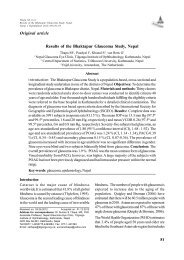nepjoph 2012.pmd - Nepalese Journal of Ophthalmology
nepjoph 2012.pmd - Nepalese Journal of Ophthalmology
nepjoph 2012.pmd - Nepalese Journal of Ophthalmology
Create successful ePaper yourself
Turn your PDF publications into a flip-book with our unique Google optimized e-Paper software.
Pathanapitoon et al<br />
Infectious uveitis<br />
Nepal J Ophthalmol 2012; 4 (8): 215-216<br />
Guest editorial<br />
Infectious uveitis: Recent advances in diagnosis and treatment<br />
Pathanapitoon K 1 , Stilma J S 2<br />
1<br />
Associate Pr<strong>of</strong>essor, Department <strong>of</strong> <strong>Ophthalmology</strong>, Chiang Mai University,<br />
110 Intawaroros Road, Chiang Mai 50200, Thailand<br />
Tel. (+66)-53-945512 E-mail: kpathana@med.cmu.ac.th<br />
2<br />
Pr<strong>of</strong>essor Emeritus <strong>of</strong> <strong>Ophthalmology</strong>, University Medical Centre, Utrecht, The Netherlands and<br />
Honorary consultant Sierra Leone<br />
Hooivaartsweg 4, 8459 ET LUINJEBERD, The Netherlands<br />
Tel. (+31)-0513-528 707 E-mail: j.stilma@hetnet.nl<br />
Uveitis can be caused by a number <strong>of</strong> different infectious agents, requiring a robust clinical experience and<br />
appropriate diagnostic tools for accurate diagnosis and treatment. A definitive diagnosis <strong>of</strong> infectious<br />
uveitis can be determined with laboratory investigations including polymerase chain reaction (PCR) analysis<br />
<strong>of</strong> intraocular fluids and the Goldmann-Witmer coefficient for local antibody production. However, in<br />
many eye care centers, these laboratory analyses are not available due to prohibitively high costs and<br />
accessibility. In these situations, a literature review <strong>of</strong> proven causes is essential to the ophthalmologist in<br />
order to make a diagnosis and devise the most effective treatment strategy for each case.<br />
Over the past few decades, there has been growing awareness <strong>of</strong> cytomegalovirus (CMV)-associated<br />
anterior uveitis (AU), which represents a distinct clinical entity that occurs in immunocompetent patients<br />
and has primarily been reported in Asia. In a recent series from Northern Thailand, 10 out <strong>of</strong> 30 (33%)<br />
immunocompetent patients with a negative initial screening for AU were confirmed to have CMV by PCR<br />
(Kongyai et al, 2012). CMV-associated AU commonly presents as a recurrent unilateral hypertensive AU<br />
that is associated with typical keratic precipitates (KPs) (white, medium sized, nodular deposits), iris<br />
atrophy, and the absence <strong>of</strong> posterior synechiae. Some cases may present with corneal endotheliitis associated<br />
with KPs. The KPs are usually seen in the inferior half <strong>of</strong> the cornea and may be diffuse, linear, ringshaped,<br />
or appear as a coin-like lesion. Additionally, they may be associated with immune ring formation.<br />
Fuch’s heterchromic iridocyclitis and Posner-Schlossman syndrome have also been associated with CMV.<br />
Fuch’s heterochromic iridocyclitis is a type <strong>of</strong> chronic uveitis associated with fine stellate KPs, iris atrophy,<br />
and cataract in the absence <strong>of</strong> synechiae. Posner-Schlossman syndrome is characterized by recurrent<br />
episodes <strong>of</strong> unilateral low-grade AU with acute onset <strong>of</strong> highly elevated intraocular pressure above 40 mm<br />
Hg without previous therapy. Currently, the treatment for CVM-associated AU includes systemic ganciclovir,<br />
intravitreal ganciclovir injections or topical ganciclovir gel for a minimum <strong>of</strong> three months. However, the<br />
overall recurrence rate is about 75.0% following antiviral therapy and do not greatly differ from eyes that<br />
did not receive antiviral treatment. Topical ganciclovir gel has a lower response rate, a lower relapse rate<br />
(25-50%) and fewer adverse effects (Jap & Chee, 2011).<br />
Another common cause <strong>of</strong> infectious uveitis is ocular toxoplasmosis (OT). OT is characterized by necrotizing<br />
retinitis that is frequently located near a retinochoroidal scar and is associated with vitreous and anterior<br />
chamber inflammation. However, in primary OT, a chorioretinal scar may be absent. Atypical clinical<br />
features <strong>of</strong> OT that have been reported include isolated anterior uveitis, intraocular inflammatory reactions<br />
without focal necrotizing retinochoroiditis, serous retinal detachment, choroiditis without retinitis, occlusive<br />
215




